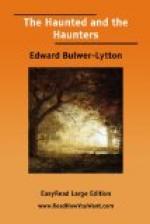The unaltered scenery of the legend still survives, and, like the field of the forty footsteps in another history, the place is still visited by those who take interest in the supernatural tales of old. The pathway leads along a moorland waste, where large masses of rock stand up here and there from the grassy turf, and clumps of heath and gorse weave their tapestry of golden purple garniture on every side. Amidst all these, and winding along between the rocks, is a natural footway worn by the scant, rare tread of the village traveller. Just midway, a somewhat larger stretch than usual of green sod expands, which is skirted by the path, and which is still identified as the legendary haunt of the phantom, by the name of Parson Rudall’s Ghost.
But we must draw the record of the first interview between the minister and Dorothy from his own words. “We met,” thus he writes, “in the pleasaunce very early, and before any others in the house were awake; and together the lad and myself proceeded towards the field. The youth was quite composed, and carried his Bible under his arm, from whence he read to me verses, which he said he had lately picked out, to have always in his mind. These were Job vii. 14, ’Thou scarest me with dreams, and terrifiest me through visions’; and Deuteronomy xxviii. 67, ’In the morning thou shalt say, Would to God it were the evening, and in the evening thou shalt say, Would to God it were morning; for the fear of thine heart wherewith thou shalt fear, and for the sight of thine eyes which thou shalt see.’
“I was much pleased with the lad’s ingenuity in these pious applications, but for mine own part I was somewhat anxious and out of cheer. For aught I knew this might be a daemonium meridianum, the most stubborn spirit to govern and guide that any man can meet, and the most perilous withal. We had hardly reached the accustomed spot, when we both saw her at once gliding towards us; punctually as the ancient writers describe the motion of their ’lemures, which swoon along the ground, neither marking the sand nor bending the herbage.’ The aspect of the woman was exactly that which had been related by the lad. There was the pale and stony face, the strange and misty hair, the eyes firm and fixed, that gazed, yet not on us, but something that they saw far, far away; one hand and arm stretched out, and the other grasping the girdle of her waist. She floated along the field like a sail upon a stream,




